Pool resurfacing is a term you’d often hear amongst pool owners, especially before pool season arrives. Swimming pool resurfacing is the process of removing the old plaster or finish of an in-ground swimming pool and applying a new surface. Many pool owners consider resurfacing their swimming pool either for cosmetic and aesthetic beautification, or to reinforce the structural integrity of their swimming pool. As a pool owner, there are certain details that you need to know when you want to resurface your private pool. These details will help you understand both the importance and the advantages of applying a new finish to your pool.
As a trusted swimming pool company, Valley Pool Plaster offers professional pool plastering and resurfacing services in different locations. We’ve serviced countless customers with our Van Nuys pool resurfacing, Reseda pool resurfacing, Calabasas pool plastering, Canoga Park pool plastering, and Winnetka pool plastering projects. Likewise, we’ve helped customers remodel their swimming pools through our Camarillo pool remodeling, Woodland Hills pool remodeling, Chatsworth pool remodeling, Hidden Hills pool remodeling, and Thousand Oaks pool remodeling projects.
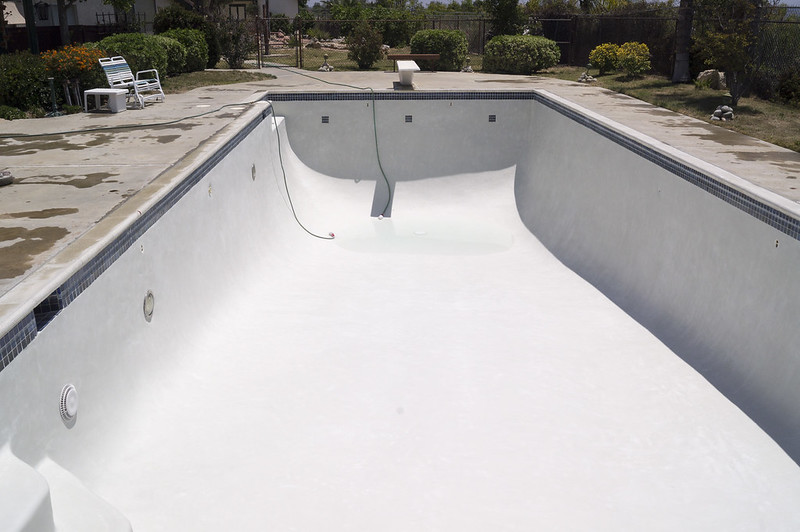
Okay, before you start to go online and search for a pool professional or a contractor to help you with resurfacing your swimming pool, it’s best to look and assess your swimming pool first. If the swimming pool you own was included with the property you’ve bought, it’s best to ask questions from your real estate agent and find out the age of the pool as well as if they know how many times was the swimming pool plastered before you got it. This will allow you to estimate the costs of resurfacing a swimming pool on a pre-owned estate. Moreover, a good swimming pool finish can last for 10 years, so knowing the dates will help you assess the quality and the current state of your swimming pool’s surface.
After knowing the history of the swimming pool, it’s best that you check for visible signs you will easily find on your property. Swimming pools that require resurfacing will often have splotches and smears on the finish. These marks can be caused by a slew of reasons, but the most common is improper swimming pool water chemical balance. Without the right chemistry, your swimming pool water might even weaken the finish in the pool and cause unwanted blemishes as the minerals in the water affect the quality of the applied surface. Other minor reasons include plant stains that happen when dead plant matter is dissolved and decomposed, as well as minor structural defects. The surface of your swimming pool can catch the stains from the color of the plant matter that has been sitting in your pool, primarily because of the chemicals in the water. The structural defect can also occur when the concrete and the soil below shift and move, causing breaks and fissures in the finish. The former will take just days to manifest while the latter will take years.
Benefits of Pool Resurfacing
As a swimming pool owner, knowing the factors that will cause your swimming pool to call for resurfacing is important, not only because you will know what things to spot and what causes them, but also because it will give you a deeper understanding of your swimming pool and the benefits of applying a new finish, which is listed below.
1. Improves swimming pool aesthetics
Of course, swimming pool aesthetics is important. What catches the eyes are usually one of the most captivating elements that draw you into a pool. You won’t know how cool or how warm the water is until you soak yourself up, but you’d know just how inviting the pool is by simply looking at it. Visuals play a huge role in the appeal of a swimming pool, so many pool owners find this benefit of great interest. That’s why swimming pool remodeling is often considered an element of swimming pool resurfacing and vice versa.
2. Extends the pool’s longevity
A new finish will definitely extend and increase the lifespan of your swimming pool. It’s pretty much like applying a new coat or a new paint on a vehicle. It will not only make it look good, but it will also protect it from minor damages since a new finish reinforces the barrier that separates the swimming pool water and the concrete below an in-ground swimming pool.
3. Save’s you money
Applying a new finish to a swimming pool will save you heaps of money in the long run. That’s because resurfacing a swimming pool will often address several issues with costs that will blow up. When you have your pool resurfaced, the contractor will often check for structural damages and will report back to you. This will be the perfect time to address these issues since it will cost you more to drain the pool again at a later time when you apply pool patches that will most likely just be band-aid solutions. Applying a fresh finish will solidify the structure of the pool.
4. Keeps your pool clean
We’re talking both literally and figuratively. Because the swimming pool no longer has marks and blemishes, you will find that the overall aesthetic value of the pool will look cleaner, especially when you use a white plaster. Moreover, because the new finish after the resurfacing is completed, you can rest assured that there will be no fissures or ruptures that will house bacteria or microorganisms. Algae and other harmful fungi that can wreak havoc into your pool will have no place to latch on or to develop.
Types of Pool Finish
Whether you’re a new swimming pool owner or if you’ve had one sitting in your backyard for years, knowing these benefits will help you make a better decision about resurfacing your swimming pool. Now that you know what to look for and the benefits of resurfacing your swimming pool, it’s time to know what your options are. Knowing what choices you have in applying a new surface to your in-ground swimming pool will help you make an informed decision as a pool owner. Here are a few.
1. Plaster Finish
One of the most common and most affordable types of swimming pool finishes. Swimming pool plaster comes in various colors and mixes, and one of the most common is white plaster. It’s a mix of Portland cement, sand, and water. This provides it its iconic white finish and offers several advantages over its colored varieties. Aside from being cheap, white plaster offers superior visibility allowing you to see things that are above the pool water and what’s sunken underneath. This helps in swimming pool maintenance and also with pool safety as you can see better if someone in the pool needs help. It also makes for an appealing and inviting backdrop that can accentuate the crystal-clear water of your swimming pool. The colored variations, on the other hand, allow you to add aesthetic value to your swimming pool and match it with other design elements surrounding your pool to give it a more cohesive appeal. While it may make the water a little murky and the colored pigmentation in the plaster mix might darken the bottom of the pool, it is often stronger than white plaster since the colored additives can add to the structural integrity of the applied plaster. Pool plastering with either white or colored plaster is a good option when you’re resurfacing on a budget.
2. Pebble Finish
Pretty much like how swimming pool plasters are made, pebble finishes are also a combination of cement, sand, water, and you guessed it – pebbles. Handpicked and carefully selected pebbles are added into the mixture, which makes it more durable and reliable. Aside from the durability it offers, pebble finishes add just the right touch of traction and adhesion, allowing those taking a dip in your swimming pool to have a better grip without risking damage to their swimsuits, swimming trunks, and even abrading their skin. Pebble finishes are great for swimming pools that are built with a lagoon-like environment, as the aesthetic value of pebble is close to stone. Because of their aesthetic value and the longevity these finishes offer, they are often more expensive than basic pool plastering.
3. Quartz Finish
Many pool experts and pool professionals consider quartz finish as a sub-type of pebble finish. That’s because in mixing the swimming pool finish, pebble is substituted for quartz. The advantages of using quartz over pebbles in terms of longevity and durability are basically the same. However, quartz finish has a more pleasing appeal because it has an aesthetic value close to sand, which makes it perfect for swimming pools that were built to make you feel like you’re at the beach. It offers all the good things you’d find in a pebble finish, only better. This means that in terms of costs, quartz finish will most likely have a relatively higher price point.
4. Fiberglass Finish
While a fiberglass finish is not usually used for an in-ground concrete pool, it still is a viable solution for swimming pool owners who want a low maintenance swimming pool. A fiberglass swimming pool finish is smooth, and unlike the porous surface of other swimming pool finishes, fiberglass finish does not invite algae, bacteria, or any other microorganisms that can hurt your swimming pool over time. If you’re also using a heater in your swimming pool, a fiberglass finish will allow the pool water to heat up faster and will allow the heat to last longer, making it more economical in the long run. That being said, the initial installation costs of a fiberglass finish is more expensive than other pool finishes, but the trade-off is its relatively low maintenance cost. It makes for a great option for those wanting to undertake pool remodeling. When remodeling your swimming pool, trust only swimming pool professionals who have credible experience. We’ve remodeled many swimming pools with our Thousand Oaks pool remodeling, Hidden Hills pool remodeling, Chatsworth pool remodeling, Woodland Hills pool remodeling, and West Hills pool remodeling solutions.
Pool Resurfacing Steps
All right! Now that you know what your choices are, you’re fully equipped to start a pool resurfacing project in your backyard. To make sure you know what you’re getting yourself into, here’s what happens during a resurfacing project.
1. Draining the Pool
To allow your contractors access to the pool’s surface, first they have to remove the pool water. Pool water is drained using your swimming pool pump, or if it cannot accommodate this action, a sump pump will do. As a swimming pool owner, you should know that the water being drained must be directed as far from the pool as possible. A good swimming pool contractor will tell you so and will drain the water towards an area sloping downwards. One compelling reason is that your in-ground pool can pop out because of the pressure of the water underneath. This will require other procedures and will require an even bigger budget. So, it’s best to know these details beforehand to avoid any issues during the resurfacing project. Once the pool is drained, your contractor will begin chipping out the old plaster, as well as other fixtures inside the pool.
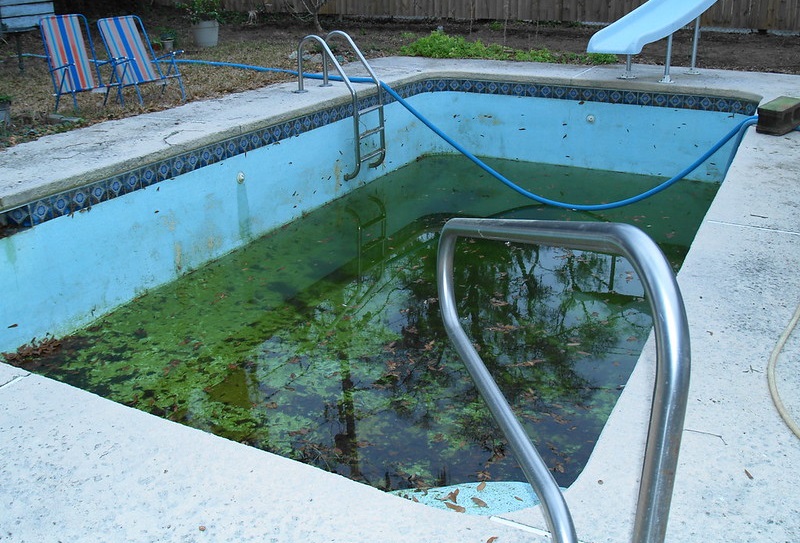
2. Chipping Out the Old Finish
To chip out the old finish on your swimming pool, your contractor will use a wide array of tools, including power tools and pneumatic tools. They may even use jackhammers, so it’s best to be ready during this stage of the resurfacing project, since it’s often the loudest. Make sure to take children and elderly somewhere quiet if they cannot stand the noise. Also, during this stage, you might need to remove the patio furniture and other fragile objects near the pool, as flying projectiles and small bits of chipped out plaster may fly out of the pool. If your contractor does not show any signs or an initiative to protect your property, do so by removing these objects and covering up exposed glass portions in your home. You may also ask the contractor to place a net to cover the swimming pool to avoid any issues.
The chipped-out debris should be removed from the property.
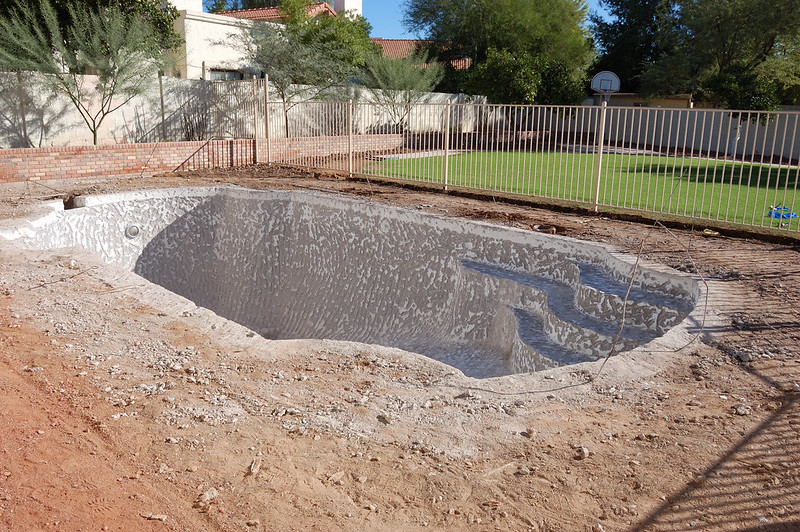
3. Application of Finish
After the old finish has been chipped out, your contractor will now apply the finish you selected. The steps may vary depending on the finish as well as the techniques used by different contractors. We, at Valley Pool Plaster, provide high-quality resurfacing services, which is why we’ve earned the trust of our customers in different areas who took up our Winnetka pool plastering, Canoga Park pool plastering, Sherman Oaks pool plastering, Calabasas pool plastering, Van Nuys pool plastering, Reseda pool resurfacing, and Van Nuys pool resurfacing solutions.
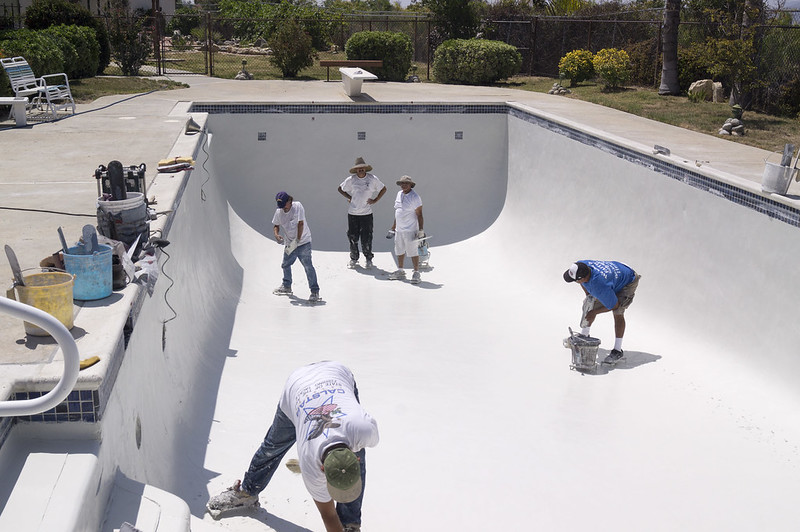

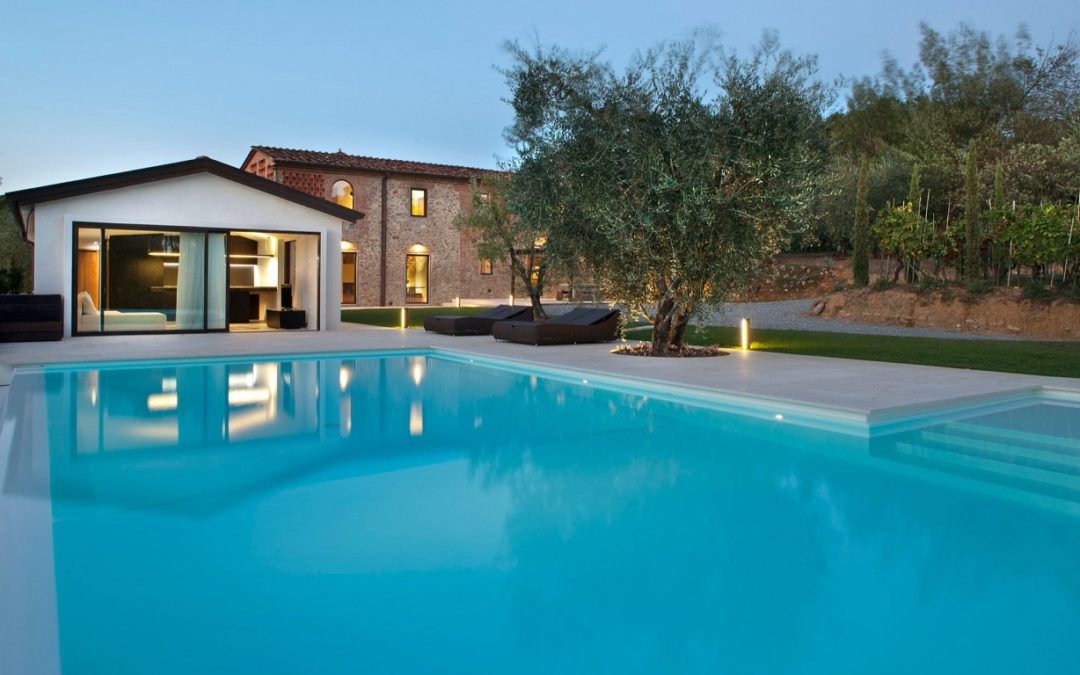
Very nice write-up. I certainly appreciate this website. Thanks!
It’s cool that you mention that you can improve the appearance of your swimming pool by having it resurfaced. I want my swimming pool to look good, so I’m thinking about having it resurfaced with fiberglass this year. I’m going to look for a good business in my area that offers fiberglass pool resurfacing services.
Thank you! Hope you find a reliable one. ?
Very Helpful Article! Thanks for sharing this to us.